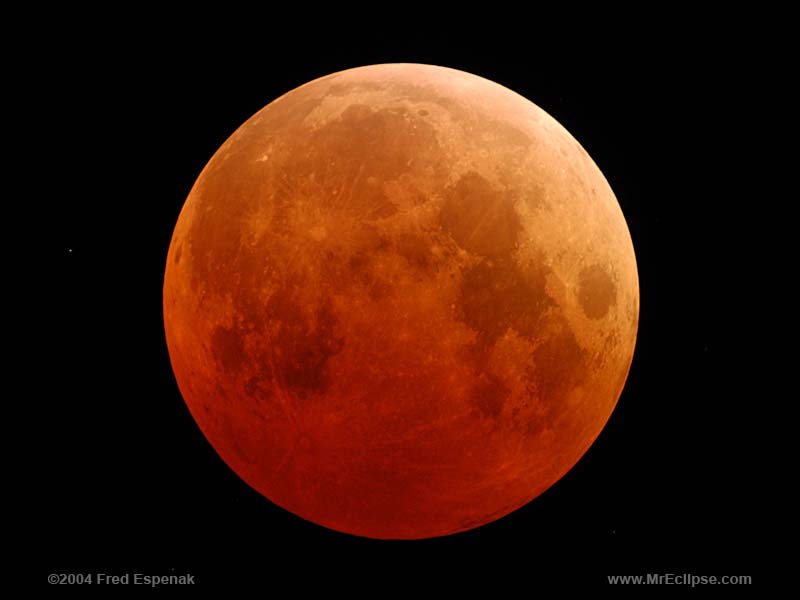
Lunar Eclipse
Introduction
What is an eclipse of the Moon? What causes eclipses and why? How often do eclipses happen and when is the next eclipse of the Moon? You’ll learn the answers to these questions and more in MrEclipse’s primer on lunar eclipses.
The Moon is a cold, rocky body about 2,160 miles (3,476 km) in diameter. It has no light of its own but shines by sunlight reflected from its surface. The Moon orbits Earth about once every 29 and a half days. As it circles our planet, the changing position of the Moon with respect to the Sun causes our natural satellite to cycle through a series of phases:
-
-
- New Moon > New Crescent > First Quarter > Waxing Gibbous> Full Moon >
Waning Gibbous > Last Quarter > Old Crescent > New Moon (again)
- New Moon > New Crescent > First Quarter > Waxing Gibbous> Full Moon >
-

The phase known as New Moon can not actually be seen because the illuminated side of the Moon is then pointed away from Earth. The rest of the phases are familiar to all of us as the Moon cycles through them month after month. Did you realize that the word month is derived from the Moon’s 29.5 day period?
Many early civilizations used the Moon’s monthly cycle to measure the passage of time. In fact, some calendars are synchronized to the phases of the Moon. The Hebrew, Muslim and Chinese calendars are all lunar calendars. The New Moon phase is uniquely recognized as the beginning of each calendar month just as it is the beginning on the Moon’s monthly cycle. In comparison, the Full Moon phase occurs mid-way through the lunar month.
The Full Moon is popularly known as the phase of love and romance. When the Moon is Full, it rises at sunset and is visible all night long. At the end of the night, the Full Moon sets just as the Sun rises. None of the Moon’s other phases have this unique characteristic. It happens because the Moon is directly opposite the Sun in the sky when the Moon is Full. Full Moon also has special significance with regard to eclipses.
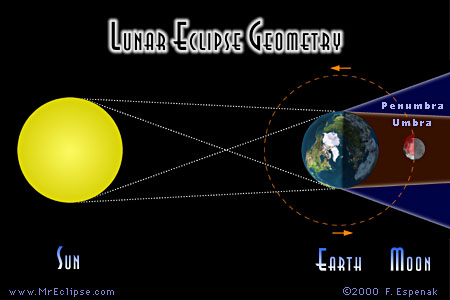
Geometry of the Sun, Earth and Moon During an Eclipse of the Moon
Earth’s two shadows are the penumbra and the umbra.
(Sizes and distances not to scale)
Types of Lunar Eclipses
An eclipse of the Moon (or lunar eclipse) can only occur at Full Moon, and only if the Moon passes through some portion of Earth’s shadow. That shadow is actually composed of two cone-shaped components, one nested inside the other. The outer or penumbral shadow is a zone where the Earth blocks part but not all of the Sun’s rays from reaching the Moon. In contrast, the inner or umbral shadow is a region where the Earth blocks all direct sunlight from reaching the Moon.
Astronomers recognize three basic types of lunar eclipses:
- Penumbral Lunar Eclipse
- The Moon passes through Earth’s penumbral shadow.
- These events are of only academic interest because they are subtle and hard to observe.
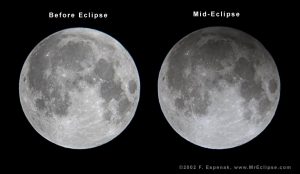
- partial lunar eclipse
- A portion of the Moon passes through Earth’s umbral shadow.
- These events are easy to see, even with the unaided eye.
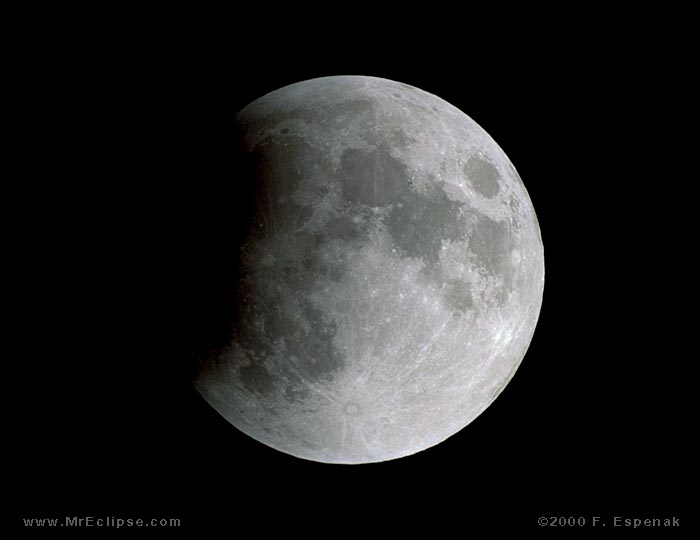
- Total Lunar Eclipse
- The entire Moon passes through Earth’s umbral shadow.
- These events are quite striking due to the Moon’s vibrant red color during the total phase (totality).

Now you might be wondering “If the Moon orbits Earth every 29.5 days and lunar eclipses only occur at Full Moon, then why don’t we have an eclipse once a month during Full Moon?”. I’m glad you asked! You see, the Moon’s orbit around Earth is actually tipped about 5 degrees to Earth’s orbit around the Sun. This means that the Moon spends most of the time either above or below the plane of Earth’s orbit. And the plane of Earth’s orbit around the Sun is important because Earth’s shadows lie exactly in the same plane. During Full Moon, our natural satellite usually passes above or below Earth’s shadows and misses them entirely. No eclipse takes place. But two to four times each year, the Moon passes through some portion of the Earth’s penumbral or umbral shadows and one of the above three types of eclipses occurs.
When an eclipse of the Moon takes place, everyone on the night side of Earth can see it. About 35% of all eclipses are of the penumbral type which are very difficult to detect, even with a telescope. Another 30% are partial eclipses which are easy to see with the unaided eye. The final 35% or so are total eclipses, and these are quite extrordinary events to behold.
What is the difference between a lunar eclipse and a solar eclipse? A solar eclipse is an eclipse of the Sun. It happens when the Moon passes between the Earth and the Sun. This is only possible when the Moon is in the New Moon phase.
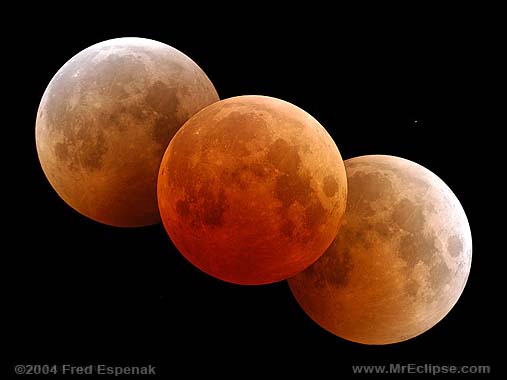
Total Lunar Eclipse of 2004 Oct 27-28
Beginning (right), middle (center) and end (left) of totality
Why is the Moon Red During a Total Lunar Eclipse?
During a total lunar eclipse, the Earth blocks the Sun’s light from reaching the Moon. Astronauts on the Moon would then see the Earth completely eclipse the Sun. (They would see a bright red ring around the Earth as they watched all the sunrises and sunsets happening simultaneousely around the world!) While the Moon remains completely within Earth’s umbral shadow, indirect sunlight still manages to reach and illuminate it. However, this sunlight must first pass deep through the Earth’s atmosphere which filters out most of the blue colored light. The remaining light is a deep red or orange in color and is much dimmer than pure white sunlight. Earth’s atmosphere also bends or refracts some of this light so that a small fraction of it can reach and illuminate the Moon.
The total phase of a lunar eclipse is so interesting and beautiful precisely because of the filtering and refracting effect of Earth’s atmosphere. If the Earth had no atmosphere, then the Moon would be completely black during a total eclipse. Instead, the Moon can take on a range of colors from dark brown and red to bright orange and yellow. The exact appearance depends on how much dust and clouds are present in Earth’s atmosphere. Total eclipses tend to be very dark after major volcanic eruptions since these events dump large amounts of volcanic ash into Earth’s atmosphere. During the total lunar eclipse of December 1992, dust from Mount Pinatubo rendered the Moon nearly invisible.
All total eclipses start with a penumbral followed by a partial eclipse, and end with a partial followed by a penumbral eclipse (the total eclipse is sandwiched in the middle). The penumbral phases of the eclipse are quite difficult to see, even with a telescope. However, partial and total eclipses are easy to observe, even with the naked eye.
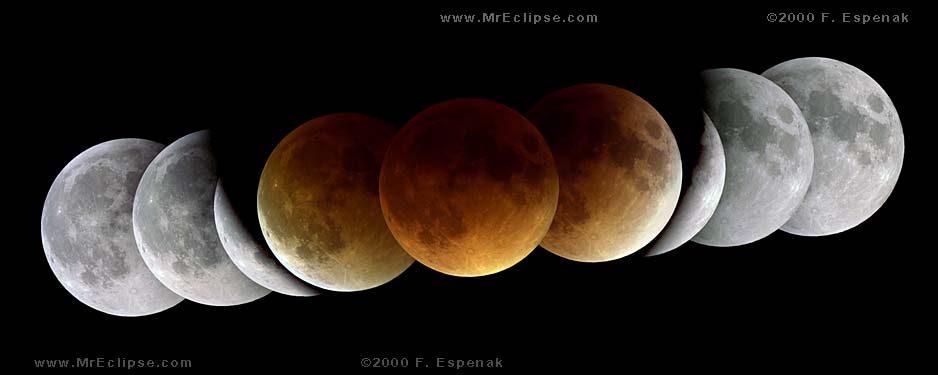
Total Lunar Eclipse of 2000 Jan 20-21
Beginning (right), middle (center) and end (left) of totality
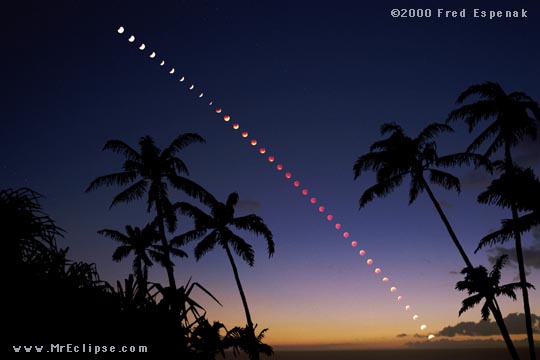
Total Lunar Eclipse Over Maui
A Nikon 8008 was used in multiple exposure mode to capture the entire eclipse
on one frame of film. A second exposure captures morning twilight.
Total Lunar Eclipse of 2000 July 16 (Lahaina, Maui)
MrEclipse.com.

